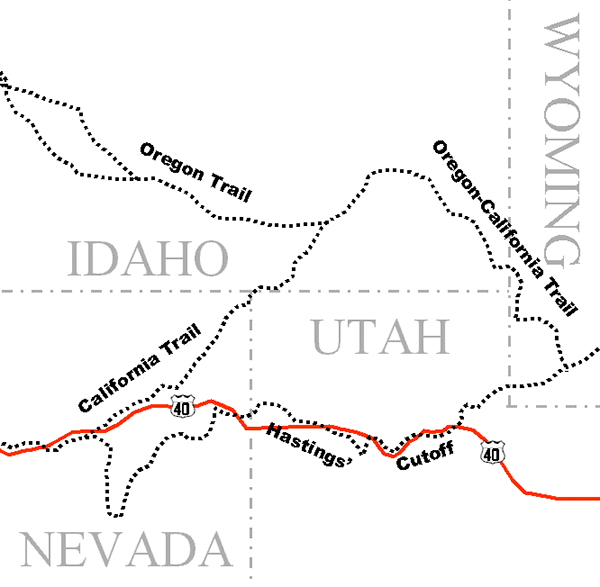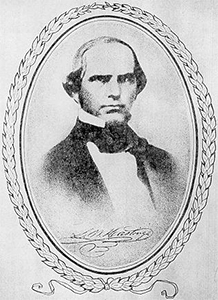You've just stumbled on the most controversial part of all of Route 40.net: the story of Lansford W. Hastings and his so-called shortcut to California.
In 1846, Lansford W. Hastings sought to bring people to California. Most scholars agree that his motive was to establish his own empire in the model of Sam Houston. To lure pioneers, he wrote an Emigrant's Guide to Oregon and California, a booklet that was based on more imagination that fact. Some label Hastings a fraud and even classify him in the cult leader ranks; other call him a visionary who was at worst misguided and uninformed. Hastings had a colorful past that took him to wherever crowds gathered. Most scholars agree that Hastings sought leadership. For a while he was active in the temperance movement, however his love of the drink proved to be an obstacle. So, Hastings set his eyes on emigrants heading to California.
Although his guide was riddled with inaccuracies, it attracted the attention of many emigrants including the Donner-Reed party of 1846. These pioneers put all of their faith in Hastings' claims to a shortcut and at Fort Bridger, Wyoming separated from the main lanes of westward travel. Alone, they cut a wagon trail across thick wooded forests and incredibly rocky terrain. In short, the Donner-Reed party was doing the difficult part of actually cutting the trail west. The cost of doing so expended much of the pioneers' valuable time and energy -- sometimes they would make less than a mile a day.
When the Donner-Reed party reached the Great Salt Lake, they thought the worst was behind them. Instead the further west they went, the harder it got. First the group had to traverse the stark and barren salt flats, a 90-mile expanse of nothing but salt and alkali. Next, the group had to endure the swampy and meandering Humboldt River. When the river dried up, they had to endure a crossing of the Forty Mile Desert - another lengthy expanse with no potable water. By the time they reached the solid vertical wall of the Sierra Nevada Mountains, it was October and the group was seriously behind schedule.
Hastings, aware that a wagon team was following his trail, left messages for the Donner-Reed party hoping to avert disaster. But it was too late. The group had crossed the point of no return and one way or another, they would be facing extreme hardship and peril. When the group reached the Sierra Nevada Mountains, virtually the entire group cursed Hastings and his supposed shortcut. As one of the Donner-Reed group advised many years later, '...don't never take no cutoffs.'
On the first day the group attempted to cross the Sierras, it began to snow. The snow didn't stop until it had reached almost twenty feet in depth. Stranded, the party made a camp at what is now Donner Lake. By the following spring, 35 of the 88 pioneers had died; those that survived did so primarily by consuming the flesh of those who had died.
Was Hastings to blame for the Donner-Reed party's tragedy? Most would agree that the blame is shared. Hastings was certainly over enthusiastic about his cutoff and he made many claims that weren't true. The Donner-Reed group were in so much of a hurry they were willing to gamble on the shortcut to save a few days of travel time. Also, the Donner-Reed party was ill-prepared for the perils and challenges of blazing a new trail across virtually unknown territory.
Route 40 roughly parallels Hastings' Cutoff between Salt Lake City, Utah and Silver Zone Pass in Nevada.
View user comments below.
|
 |
 |
Hastings Cutoff
|
|
 |
 |
Lansford W. Hastings
|
|
 |
 |
Salt Flats and Hastings Cutoff. Courtesy of the Library of Congress/Historic American Buildings Survey. Click here for a larger display.
|
For more information:

































